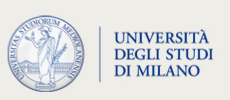How to avoid plagiarism
Applicable laws and regulations define plagiarism as the unlawful use of other people’s texts or ideas, “arising when someone presents someone else’s work as their own, either partly or in its entirety, without acknowledging the real author” (Settimio Paolo Cavalli, Alberto Pojaghi. Dizionario del diritto d’autore [Dictionary of Copyright]. Milano: Editrice Bibliografica, 2003).
Here are a few examples of behaviours that constitute plagiarism:
- misciting or failing to cite sources when copying sentences, data, graphs, photos and any other materials published or in any case made public by other people
- paraphrasing works and ideas of another author without including a proper citation
- translating texts into another language without acknowledging the source
- presenting sentences pronounced by professors during classes as one’s own
- reusing one’s own words from previously published or peer-reviewed works (self-plagiarism).
Check our tips on how to avoid plagiarism
Regulatory framework
Plagiarism falls under copyright law, even though Law no. 633/1941 (the Italian Law on copyright) does not mention it explicitly (Settimio Paolo Cavalli, Alberto Pojaghi. Dizionario del diritto d’autore [Dictionary of Copyright]. Milano: Editrice Bibliografica, 2003).
The Directorate-General for Libraries and Copyright of the Italian Ministry of Culture maintains an up-to-date list of legal and regulatory acts on copyright, which is available at https://librari.beniculturali.it/it/diritto-dautore/normativa
More specifically, Italian Law no. 475/1925 (Law on the Repression of false attribution of other people’s work by applicants for the award of degrees, diplomas, offices, titles and public appointments) contains specific provisions on copyright in academia.
Another useful resource are the FAQs on Author’s Right, Copyright and Open Licenses for Culture on the Web written by the Digital Cultural Heritage research group of ICOM Italy, which are also available on the website of the Ministry of Culture.


